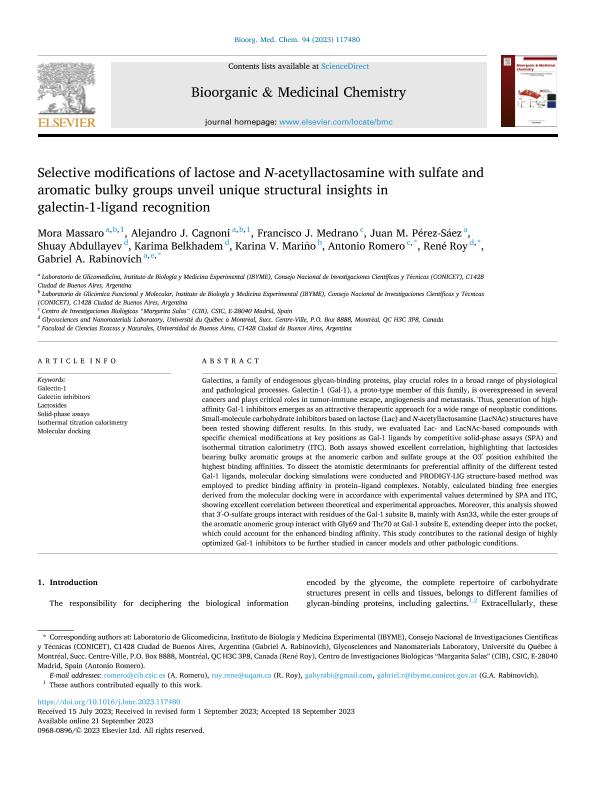Mostrar el registro sencillo del ítem
dc.contributor.author
Massaro, Mora

dc.contributor.author
Cagnoni, Alejandro

dc.contributor.author
Medrano, Francisco J.
dc.contributor.author
Pérez Sáez, Juan Manuel

dc.contributor.author
Abdullayev, Shuay
dc.contributor.author
Belkhadem, Karima
dc.contributor.author
Mariño, Karina Valeria

dc.contributor.author
Romero, Antonio
dc.contributor.author
Roy, René
dc.contributor.author
Rabinovich, Gabriel Adrián

dc.date.available
2024-03-21T12:37:34Z
dc.date.issued
2023-10
dc.identifier.citation
Massaro, Mora; Cagnoni, Alejandro; Medrano, Francisco J.; Pérez Sáez, Juan Manuel; Abdullayev, Shuay; et al.; Selective modifications of lactose and N-acetyllactosamine with sulfate and aromatic bulky groups unveil unique structural insights in galectin-1-ligand recognition; Pergamon-Elsevier Science Ltd; Bioorganic and Medicinal Chemistry; 94; 10-2023; 1-10
dc.identifier.issn
0968-0896
dc.identifier.uri
http://hdl.handle.net/11336/231114
dc.description.abstract
Galectins, a family of endogenous glycan-binding proteins, play crucial roles in a broad range of physiological and pathological processes. Galectin-1 (Gal-1), a proto-type member of this family, is overexpressed in several cancers and plays critical roles in tumor-immune escape, angiogenesis and metastasis. Thus, generation of high-affinity Gal-1 inhibitors emerges as an attractive therapeutic approach for a wide range of neoplastic conditions. Small-molecule carbohydrate inhibitors based on lactose (Lac) and N-acetyllactosamine (LacNAc) structures have been tested showing different results. In this study, we evaluated Lac- and LacNAc-based compounds with specific chemical modifications at key positions as Gal-1 ligands by competitive solid-phase assays (SPA) and isothermal titration calorimetry (ITC). Both assays showed excellent correlation, highlighting that lactosides bearing bulky aromatic groups at the anomeric carbon and sulfate groups at the O3′ position exhibited the highest binding affinities. To dissect the atomistic determinants for preferential affinity of the different tested Gal-1 ligands, molecular docking simulations were conducted and PRODIGY-LIG structure-based method was employed to predict binding affinity in protein–ligand complexes. Notably, calculated binding free energies derived from the molecular docking were in accordance with experimental values determined by SPA and ITC, showing excellent correlation between theoretical and experimental approaches. Moreover, this analysis showed that 3′-O-sulfate groups interact with residues of the Gal-1 subsite B, mainly with Asn33, while the ester groups of the aromatic anomeric group interact with Gly69 and Thr70 at Gal-1 subsite E, extending deeper into the pocket, which could account for the enhanced binding affinity. This study contributes to the rational design of highly optimized Gal-1 inhibitors to be further studied in cancer models and other pathologic conditions.
dc.format
application/pdf
dc.language.iso
eng
dc.publisher
Pergamon-Elsevier Science Ltd

dc.rights
info:eu-repo/semantics/openAccess
dc.rights.uri
https://creativecommons.org/licenses/by/2.5/ar/
dc.subject
GALECTIN INHIBITORS
dc.subject
GALECTIN-1
dc.subject
ISOTHERMAL TITRATION CALORIMETRY
dc.subject
LACTOSIDES
dc.subject
MOLECULAR DOCKING
dc.subject
SOLID-PHASE ASSAYS
dc.subject.classification
Bioquímica y Biología Molecular

dc.subject.classification
Ciencias Biológicas

dc.subject.classification
CIENCIAS NATURALES Y EXACTAS

dc.title
Selective modifications of lactose and N-acetyllactosamine with sulfate and aromatic bulky groups unveil unique structural insights in galectin-1-ligand recognition
dc.type
info:eu-repo/semantics/article
dc.type
info:ar-repo/semantics/artículo
dc.type
info:eu-repo/semantics/publishedVersion
dc.date.updated
2024-02-22T12:59:52Z
dc.identifier.eissn
1464-3391
dc.journal.volume
94
dc.journal.pagination
1-10
dc.journal.pais
Estados Unidos

dc.description.fil
Fil: Massaro, Mora. Consejo Nacional de Investigaciones Científicas y Técnicas. Instituto de Biología y Medicina Experimental. Fundación de Instituto de Biología y Medicina Experimental. Instituto de Biología y Medicina Experimental; Argentina
dc.description.fil
Fil: Cagnoni, Alejandro. Consejo Nacional de Investigaciones Científicas y Técnicas. Instituto de Biología y Medicina Experimental. Fundación de Instituto de Biología y Medicina Experimental. Instituto de Biología y Medicina Experimental; Argentina
dc.description.fil
Fil: Medrano, Francisco J.. Consejo Superior de Investigaciones Científicas. Centro de Investigaciones Biológicas; España
dc.description.fil
Fil: Pérez Sáez, Juan Manuel. Consejo Nacional de Investigaciones Científicas y Técnicas. Instituto de Biología y Medicina Experimental. Fundación de Instituto de Biología y Medicina Experimental. Instituto de Biología y Medicina Experimental; Argentina
dc.description.fil
Fil: Abdullayev, Shuay. Université du Québec a Montreal; Canadá
dc.description.fil
Fil: Belkhadem, Karima. Université du Québec a Montreal; Canadá
dc.description.fil
Fil: Mariño, Karina Valeria. Consejo Nacional de Investigaciones Científicas y Técnicas. Instituto de Biología y Medicina Experimental. Fundación de Instituto de Biología y Medicina Experimental. Instituto de Biología y Medicina Experimental; Argentina
dc.description.fil
Fil: Romero, Antonio. Consejo Superior de Investigaciones Científicas. Centro de Investigaciones Biológicas; España
dc.description.fil
Fil: Roy, René. Université du Québec a Montreal; Canadá
dc.description.fil
Fil: Rabinovich, Gabriel Adrián. Consejo Nacional de Investigaciones Científicas y Técnicas. Instituto de Biología y Medicina Experimental. Fundación de Instituto de Biología y Medicina Experimental. Instituto de Biología y Medicina Experimental; Argentina
dc.journal.title
Bioorganic and Medicinal Chemistry

dc.relation.alternativeid
info:eu-repo/semantics/altIdentifier/url/https://www.sciencedirect.com/science/article/pii/S0968089623003280
dc.relation.alternativeid
info:eu-repo/semantics/altIdentifier/doi/http://dx.doi.org/10.1016/j.bmc.2023.117480
Archivos asociados
